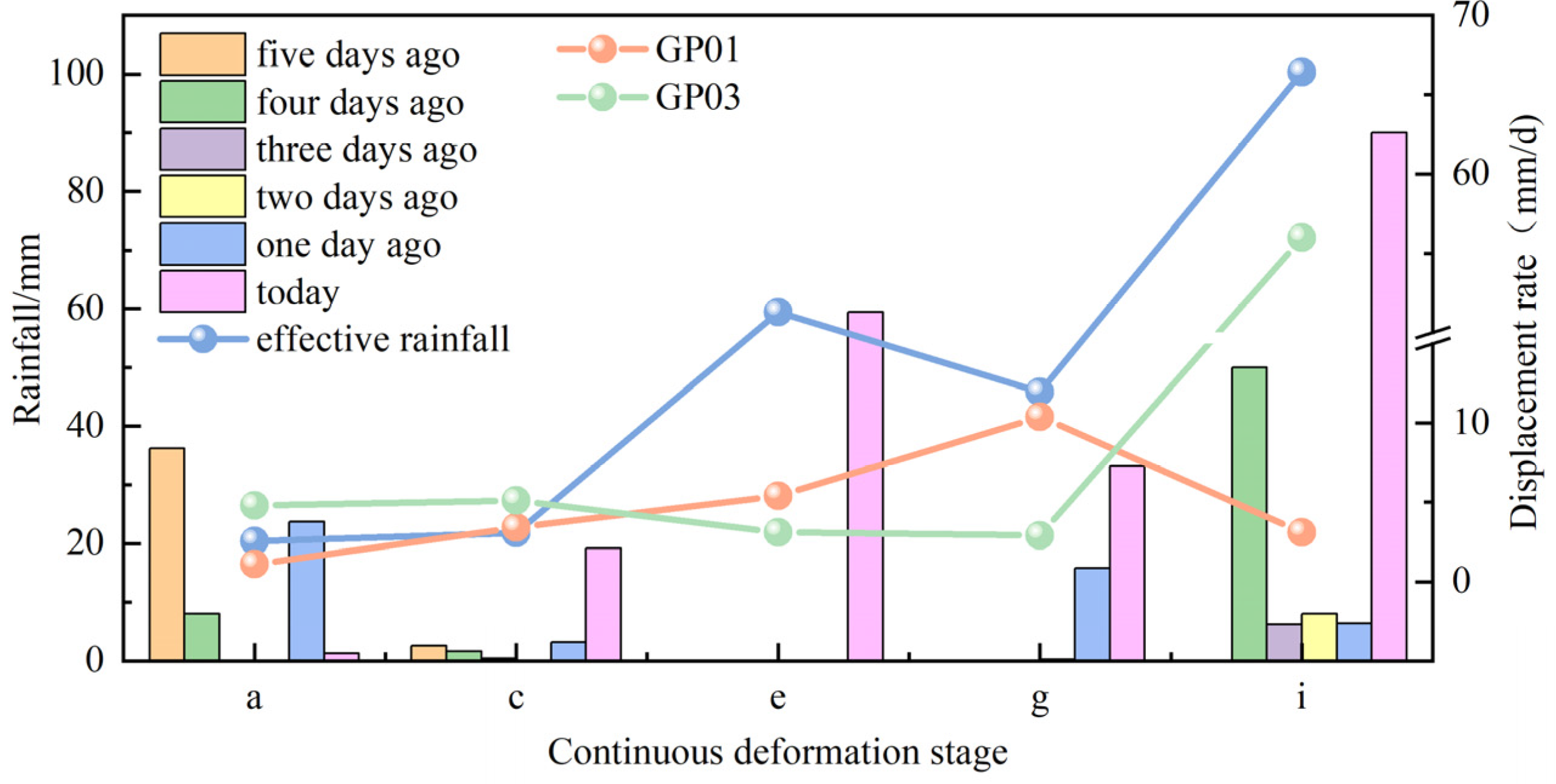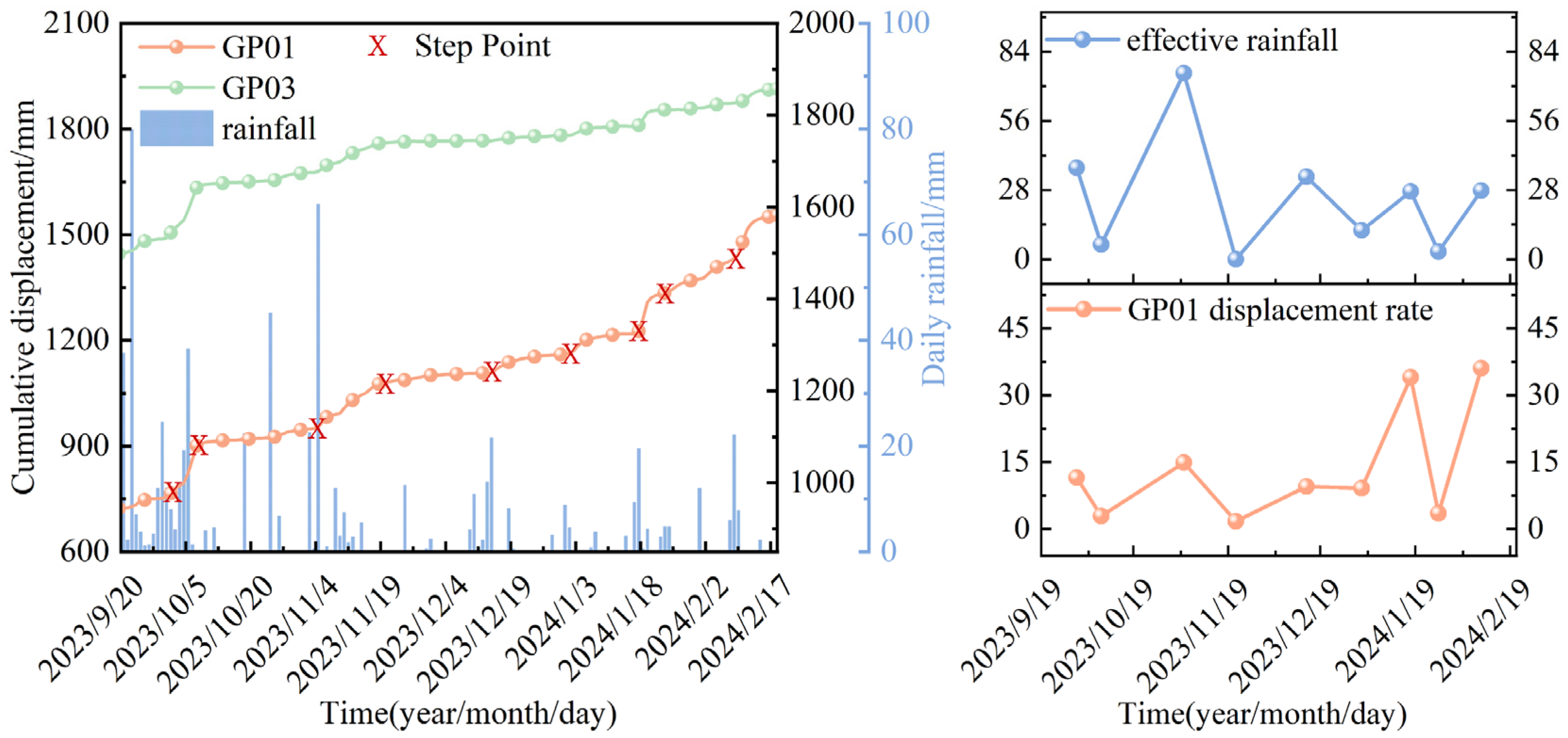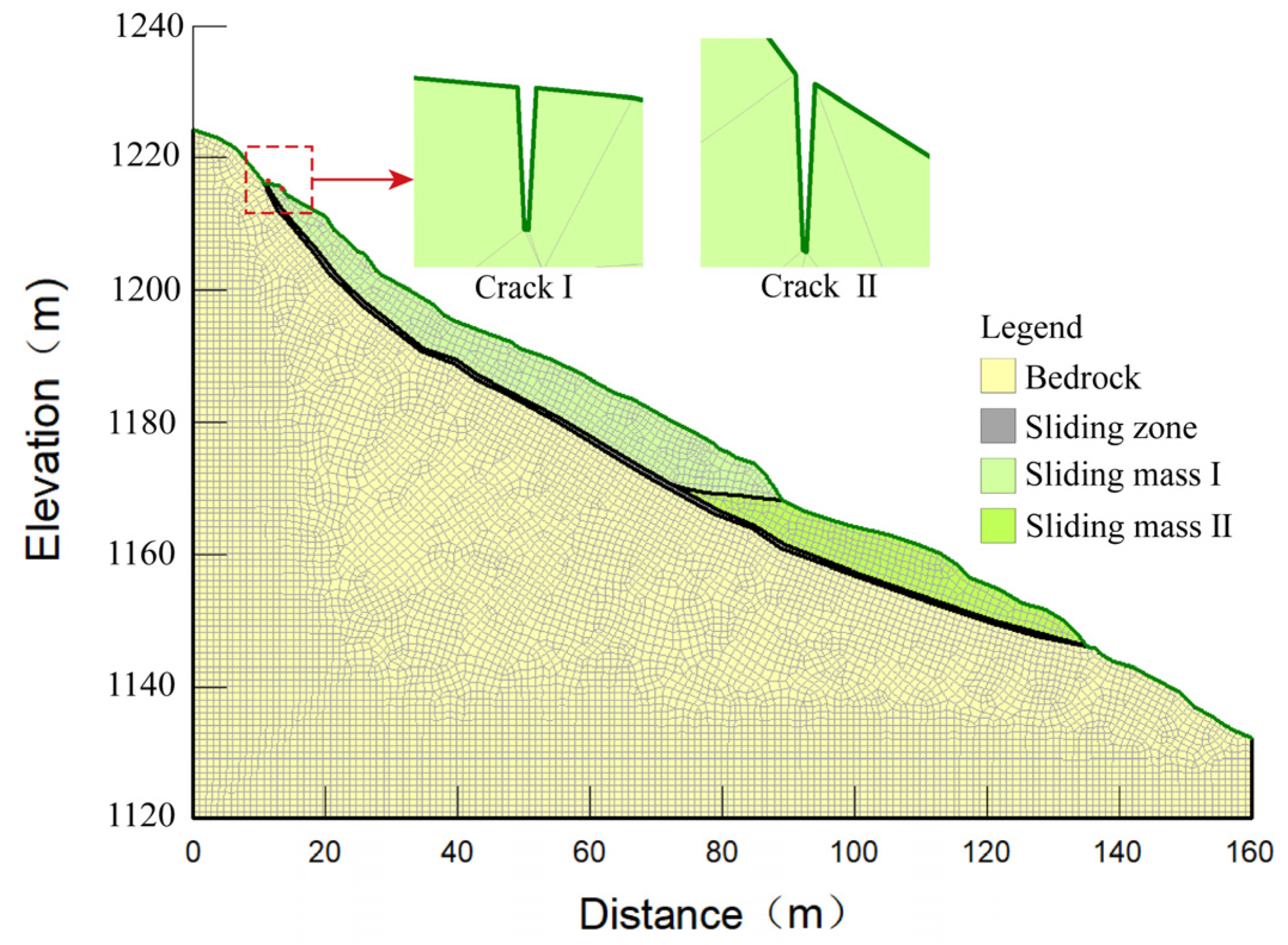Study on the Deformation Mechanism of Shallow Soil Landslides Under the Coupled Effects of Crack Development, Road Loading, and Rainfall
Abstract
1. Introduction
2. Case Study: Baiyansizu Landslide
2.1. Geographical and Geological Settings
2.2. Field Investigation of Baiyansizu Landslide
2.3. Layout of Monitoring Points
2.4. Ground Deformation Monitoring
3. Landslide Numerical Simulation
3.1. Goals of Numerical Experiments Using GeoStudio
3.2. Implementation of Numerical Model
3.3. Simulation Results and Analysis
4. Discussion
4.1. The Impact of Rainfall Infiltration on Landslides
4.2. The Control of Crack Conditions on the Evolution of Shallow Landslides
4.3. Road Load Promotes the Deformation of Shallow Landslides
5. Conclusions
- The deformation at the trailing edge of the Baiyansizu landslide is primarily influenced by rainfall patterns. Effective rainfall exerts a dual regulatory mechanism on landslide deformation: long-term rainfall diminishes shear strength through continuous infiltration, resulting in progressive creep, while short-term heavy rainfall induces step-like deformation due to instantaneous surges in pore water pressure. This underscores the significance of early warning systems for extreme weather events.
- GeoStudio numerical simulations indicate that the stability of the Baiyansizu landslide is influenced by multi-field coupled nonlinearities. The fissures at the trailing edge significantly enhance the efficiency of rainfall infiltration, becoming the primary factor contributing to deformation. Cyclic dynamic loading expedites the penetration of the plastic zone within the sliding belt, thereby amplifying the displacement accumulation. When the stability coefficient exceeds the critical value, the landslide experiences accelerated creep. Additionally, road loads and their associated cyclic dynamic loading facilitate the expansion of fissures and the densification of the soil, collectively accelerating the deformation process of the shallow landslide.
- A comparative analysis of five typical landslide cases reveals the significant influence of geological factors on external disturbances. Variations in landslide thickness, crack development, road load, and rainfall infiltration contribute to differing deformation characteristics and mechanisms. In landslide prevention and control efforts, the impact of rainfall infiltration must be thoroughly considered, and targeted measures should be implemented based on the specific types and characteristics of each landslide.
Author Contributions
Funding
Data Availability Statement
Acknowledgments
Conflicts of Interest
References
- Mondini, A.C.; Guzzetti, F.; Melillo, M. Deep learning forecast of rainfall-induced shallow landslides. Nat. Commun. 2023, 14, 2466. [Google Scholar] [CrossRef] [PubMed]
- Fan, L.; Lehmann, P.; Zheng, C.; Or, D. Rainfall Intensity Temporal Patterns Affect Shallow Landslide Triggering and Hazard Evolution. Geophys. Res. Lett. 2020, 47, e2019GL085994. [Google Scholar] [CrossRef]
- Li, W.; Liu, C.; Scaioni, M.; Sun, W.; Chen, Y.; Yao, D.; Chen, S.; Hong, Y.; Zhang, K.; Cheng, G. Spatio-temporal analysis and simulation on shallow rainfall-induced landslides in China using landslide susceptibility dynamics and rainfall I-D thresholds. Sci. China Earth Sci. 2017, 60, 720–732. [Google Scholar] [CrossRef]
- Lee, J.-H.; Kim, H.; Park, H.-J.; Heo, J.-H. Temporal prediction modeling for rainfall-induced shallow landslide hazards using extreme value distribution. Landslides 2021, 18, 321–338. [Google Scholar] [CrossRef]
- La Porta, G.; Leonardi, A.; Pirulli, M.; Cafaro, F.; Castelli, F. Time-resolved triggering and runout analysis of rainfall-induced shallow landslides. Acta Geotech. 2024, 19, 1873–1889. [Google Scholar] [CrossRef]
- Wu, Z.; Ye, R.; Yang, S.; Wen, T.; Huang, J.; Chen, Y. Study on Early Identification of Rainfall-Induced Accumulation Landslide Hazards in the Three Gorges Reservoir Area. Remote Sens. 2024, 16, 1669. [Google Scholar] [CrossRef]
- Li, W.C.; Dai, F.C.; Wei, Y.Q.; Wang, M.L.; Min, H.; Lee, L.M. Implication of subsurface flow on rainfall-induced landslide: A case study. Landslides 2015, 13, 1109–1123. [Google Scholar] [CrossRef]
- Zhuang, Y.; Xing, A.; Sun, Q.; Jiang, Y. Insights into initiation of typhoon-induced deep-seated landslides in Southeast coastal China. Nat. Hazards 2023, 119, 721–749. [Google Scholar] [CrossRef]
- Wen, H.; Xiao, J.; Wang, X.; Xiang, X.; Zhou, X. Analysis of Soil–Water Characteristics and Stability Evolution of Rainfall-Induced Landslide: A Case of the Siwan Village Landslide. Forests 2023, 14, 808. [Google Scholar] [CrossRef]
- Tsai, T.-L. Influences of soil water characteristic curve on rainfall-induced shallow landslides. Environ. Earth Sci. 2011, 64, 449–459. [Google Scholar] [CrossRef]
- Balzano, B.; Tarantino, A.; Ridley, A. Preliminary analysis on the impacts of the rhizosphere on occurrence of rainfall-induced shallow landslides. Landslides 2019, 16, 1885–1901. [Google Scholar] [CrossRef]
- Wu, T.; Li, H.-C.; Wei, S.-P.; Chen, W.-B.; Chen, Y.-M.; Su, Y.-F.; Liu, J.-J.; Shih, H.-J. A comprehensive disaster impact assessment of extreme rainfall events under climate change: A case study in Zheng-wen river basin, Taiwan. Environ. Earth Sci. 2016, 75, 597. [Google Scholar] [CrossRef]
- Ali, A.; Huang, J.; Lyamin, A.; Sloan, S.; Cassidy, M. Boundary effects of rainfall-induced landslides. Comput. Geotech. 2014, 61, 341–354. [Google Scholar] [CrossRef]
- Lai, Q.; Zhao, J.; Shi, B.; Liu, H.; Ji, L.; Li, Q.; Huang, R. Deformation evolution of landslides induced by coal mining in mountainous areas: Case study of the Madaling landslide, Guizhou, China. Landslides 2023, 20, 2003–2016. [Google Scholar] [CrossRef]
- Liu, Z.; Liang, C.; Sens-Schönfelder, C.; Hu, W.; Sun, X.; Zhang, T.; Xu, R.; Jiang, Z.; Jiang, H. Monitoring crack opening via seismic velocity variation to assess that fatal effect of precipitation for landslide motion. Earth Planet. Sci. Lett. 2024, 644, 118922. [Google Scholar] [CrossRef]
- Miao, M.; Tang, H.; Fang, K.; Jiang, Y.; Li, C.; Lv, B. Influence of tensile crack development on the deformation behavior and failure mode of reservoir-induced landslides: Insights from model tests. Landslides 2025. Advance online publication. [Google Scholar] [CrossRef]
- Sepúlveda, S.A.; Petley, D.N.; Brain, M.J.; Tunstall, N. The effect of dynamic loading on the shear strength of pyroclastic Ash Deposits and implications for landslide hazard: The case of Pudahuel Ignimbrite, Chile. Eng. Geol. 2016, 205, 54–61. [Google Scholar] [CrossRef]
- Paronuzzi, P.; Bolla, A. In-depth field survey of a rockslide detachment surface to recognise the occurrence of gravity-induced cracking. Eng. Geol. 2022, 302, 106636. [Google Scholar] [CrossRef]
- Chen, G.; Li, P.; Leng, Z.; Wu, T.; Li, C.; Xiang, J.; Liu, Y.; Huo, P. Transient model of unsteady creep of sliding zone soil under cyclic dynamic load based on fractional derivative. Alex. Eng. J. 2023, 83, 212–221. [Google Scholar] [CrossRef]
- Luo, Y.; Zhang, J.; Zhou, Z.; Jiang, G.; Duan, M. Effects of improper emergency mitigations on a large-scale landslide triggered by road excavation: A case study of the Fengping landslide, Hubei province, China. Bull. Eng. Geol. Environ. 2024, 83, 258. [Google Scholar] [CrossRef]
- Yang, X.; Chen, Y. Characteristics and mechanism of landslides on highway landfill along Xiaolangdi Reservoir of the Yellow River: A case study. Nat. Hazards 2024, 120, 10321–10343. [Google Scholar] [CrossRef]
- Sun, S.; Jiang, Z.; Li, L.; Qiu, D. Model test and numerical verification of surrounding rock stability of super-large-span and variable-section tunnels. Tunn. Undergr. Space Technol. 2024, 153, 106020. [Google Scholar] [CrossRef]
- Huang, F.; Chen, J.; Liu, W.; Huang, J.; Hong, H.; Chen, W. Regional rainfall-induced landslide hazard warning based on landslide susceptibility mapping and a critical rainfall threshold. Geomorphology 2022, 408, 108236. [Google Scholar] [CrossRef]
- Zhang, G.; Wang, R.; Qian, J.; Zhang, J.-M.; Qian, J. Effect study of cracks on behavior of soil slope under rainfall conditions. Soils Found. 2012, 52, 634–643. [Google Scholar] [CrossRef]
- Zhang, L.; Jiang, X.; Sun, R.; Gu, H.; Fu, Y.; Qiu, Y. Stability analysis of unsaturated soil slopes with cracks under rainfall infiltration conditions. Comput. Geotech. 2023, 165, 105907. [Google Scholar] [CrossRef]
- Jiao, W.; Zhang, M.; Li, P.; Xie, J.; Pang, H.; Liu, F.; Yang, L. Evolution model and failure mechanisms of rainfall-induced cracked red clay slopes: Insights from Xinshao County, China. J. Mt. Sci. 2024, 21, 509–523. [Google Scholar] [CrossRef]
- Gratchev, I. Insights into the mechanism of earthquake-triggered landslides in plastic fine-grained soils. Soil Dyn. Earthq. Eng. 2023, 173, 108134. [Google Scholar] [CrossRef]
- Liang, Z.; Xu, J.; Cao, H.; Zeng, Y.; Wu, T. Theoretical study on the mechanism of slope sliding resistance and sliding force on multi-field coupling instability. Ain Shams Eng. J. 2024, 15, 103072. [Google Scholar] [CrossRef]
- Huang, X.H.; Lei, D.X.; Xia, J.B.; Yi, W.; Zhang, P. Forecast analysis and application of stepwise deformation of landslide induced by rainfall. Rock Soil Mech. China 2019, 40, 3585–3592, 3602. [Google Scholar] [CrossRef]
- Hou, T.-S.; Xu, G.-L.; Zhang, D.-Q.; Liu, H.-Y. Stability analysis of Gongjiacun landslide in the three Gorges Reservoir area under the action of reservoir water level fluctuation and rainfall. Nat. Hazards 2022, 114, 1647–1683. [Google Scholar] [CrossRef]
- Wang, L.; Zhang, K.; Chen, Y.; Wang, S.; Tian, D.; Li, X.; He, Y. Progressive deformation mechanism of colluvial landslides induced by rainfall: Insights from long-term field monitoring and numerical study. Landslides 2024, 21, 3069–3086. [Google Scholar] [CrossRef]
- JTG D60—2004; General Code for Design of Highway Bridges and Culverts. China Communications Press: Beijing, China, 2004.
- Wang, B.; Zuo, Q.; Deng, M.; Yi, Q.; Ruan, D.; Liang, Z. Study on the deformation mechanism of chair-like bedding rock landslides under the coupling effect of geological and hydrological factors. Eng. Geol. 2024, 344, 107832. [Google Scholar] [CrossRef]
- Zhou, C.; Cao, Y.; Yin, K.; Intrieri, E.; Catani, F.; Wu, L. Characteristic comparison of seepage-driven and buoyancy-driven landslides in Three Gorges Reservoir area, China. Eng. Geol. 2022, 301, 106590. [Google Scholar] [CrossRef]
- Song, K.; Han, L.; Ruan, D.; Li, H.; Ma, B. Stability Prediction of Rainfall-Induced Shallow Landslides: A Case Study of Mountainous Area in China. Water 2023, 15, 2938. [Google Scholar] [CrossRef]
- Ren, Y.; Li, T.; Dong, S.; Tang, J.; Xue, D. Rainfall-induced reactivation mechanism of a landslide with multiple-soft layers. Landslides 2020, 17, 1269–1281. [Google Scholar] [CrossRef]
- Chen, G.; Bian, S.; Ma, J.; Meng, X.; Shi, W.; Wu, J.; Zhang, Y.; Li, Y. Field experiment on the spatiotemporal evolution of soil moisture in a rainfall-induced loess landslide: Implications for early warning. J. Hydrol. 2024, 630, 130777. [Google Scholar] [CrossRef]
- Sun, P.; Wang, G.; Wu, L.Z.; Igwe, O.; Zhu, E. Physical model experiments for shallow failure in rainfall-triggered loess slope, Northwest China. Bull. Eng. Geol. Environ. 2018, 78, 4363–4382. [Google Scholar] [CrossRef]
- Sun, H.-Y.; Pan, P.; Lü, Q.; Wei, Z.-L.; Xie, W.; Zhan, W. A case study of a rainfall-induced landslide involving weak interlayer and its treatment using the siphon drainage method. Bull. Eng. Geol. Environ. 2018, 78, 4063–4074. [Google Scholar] [CrossRef]
- Hu, W.; Hu, W.; Luo, H.; Luo, H.; Xu, Q.; Xu, Q.; McSaveney, M.; McSaveney, M.; Huang, R.; Huang, R.; et al. Effect of Amplitude and Duration of Cyclic Loading on Frictional Sliding Instability in Granular Media: Implication to Earthquake Triggering of Landslides. J. Geophys. Res. Solid Earth 2022, 127, e2022JB024488. [Google Scholar] [CrossRef]
- Li, S.; Wang, J.; Han, K.; Wang, L.; Zhang, D.; Dong, H.; Cui, B. Promoting effect and microscopic mechanism of train-induced vibration on loess disintegration. Eng. Geol. 2024, 336, 107559. [Google Scholar] [CrossRef]













| Stage | Time | Automatic Monitoring Point | Displacement Data (mm) | Daily Average Displacement Rate (mm/Day) | Accumulated Rainfall (mm) | Daily Average Rainfall (mm/Day) | Maximum Daily Rainfall (mm) | Effective Rainfall (mm) |
|---|---|---|---|---|---|---|---|---|
| a | 2022/4/29–2022/8/20 | GP01 | 122.8 | 1.1 | 471.1 | 4.1 | 53.2 | 20.4 |
| GP03 | 552.4 | 4.8 | ||||||
| c | 2023/3/23–2023/8/17 | GP01 | 510.4 | 3.4 | 803.5 | 5.4 | 53 | 21.8 |
| GP03 | 763.2 | 5.1 | ||||||
| e | 2023/9/20–2024/2/19 | GP01 | 832.6 | 5.4 | 734.8 | 4.8 | 80 | 59.4 |
| GP03 | 469 | 3.1 | ||||||
| g | 2024/3/25–2024/5/16 | GP01 | 552.5 | 10.4 | 215.6 | 4.1 | 33.2 | 45.8 |
| GP03 | 154.6 | 2.9 | ||||||
| i | 2024/7/13–2024/7/22 | GP01 | 30.7 | 3.1 | 96.6 | 9.66 | 90 | 100.3 |
| GP03 | 560 | 56 |
| Parameters | Bulk Density (KN/m3) | Cohesion (kPa) | Friction (°) | Saturated Volumetric Water Content (%) | Permeability Coefficient (m/d) |
|---|---|---|---|---|---|
| Sliding mass I | 20.9 | 18.9 | 22 | 29.6 | 30 |
| Sliding mass II | 20.9 | 18.9 | 22 | 29.6 | 10 |
| Sliding zone | 20.5 | 16 | 17 | 29.4 | 0.296 |
| Bedrock | 22 | 20 | 15 | 10 | 0.02 |
| Condition Design | |
|---|---|
| Condition I | Stage e, effective rainfall |
| Condition II | Stage e, effective rainfall, periodic dynamic load |
| Condition III | Stage e, effective rainfall, crack conditions |
| Condition VI | Stage e, effective rainfall, crack conditions, periodic dynamic load |
| Landslide | Type of Landslide | Crack Conditions | Surface Loading |
|---|---|---|---|
| Baiyansizu landslide | Shallow landslide | Multiple cracks have developed at the trailing edge of the road, presenting an arc shape and penetrating through, with widths varying from 5 to 20 cm | Highways, houses, vegetation, etc. |
| Tudiling landslide | Shallow landslide | Multiple cracks have developed at the trailing edge, measuring between 5 and 10 m in length and 5 to 10 cm in width | Highways, houses, vegetation, etc. |
| Chengnan landslide | Shallow landslide | Multiple tensile cracks have developed, with widths ranging from 3 to 5 cm, and the annular crack at the trailing edge has expanded to a length of 100 m | Highways, houses, vegetation, etc. |
| Tanjiawan landslide | Medium-thick-layer landslide | Multiple tensile cracks have developed in the middle and rear sections, measuring between 5 to 80 m in length and 4 to 30 centim in width | Highways, houses, vegetation, etc. |
| Bazimen landslide | Thick-layer landslide | Multiple tensile cracks have formed beneath the front edge road, with lengths ranging from 50 to 200 m and widths varying between 1 and 15 centim | Highways, houses, vegetation, etc. |
Disclaimer/Publisher’s Note: The statements, opinions and data contained in all publications are solely those of the individual author(s) and contributor(s) and not of MDPI and/or the editor(s). MDPI and/or the editor(s) disclaim responsibility for any injury to people or property resulting from any ideas, methods, instructions or products referred to in the content. |
© 2025 by the authors. Licensee MDPI, Basel, Switzerland. This article is an open access article distributed under the terms and conditions of the Creative Commons Attribution (CC BY) license (https://creativecommons.org/licenses/by/4.0/).
Share and Cite
Fei, P.; Yi, Q.; Deng, M.; Wang, B.; Song, Y.; Liu, L. Study on the Deformation Mechanism of Shallow Soil Landslides Under the Coupled Effects of Crack Development, Road Loading, and Rainfall. Water 2025, 17, 1196. https://doi.org/10.3390/w17081196
Fei P, Yi Q, Deng M, Wang B, Song Y, Liu L. Study on the Deformation Mechanism of Shallow Soil Landslides Under the Coupled Effects of Crack Development, Road Loading, and Rainfall. Water. 2025; 17(8):1196. https://doi.org/10.3390/w17081196
Chicago/Turabian StyleFei, Peiyan, Qinglin Yi, Maolin Deng, Biao Wang, Yuhang Song, and Longchuan Liu. 2025. "Study on the Deformation Mechanism of Shallow Soil Landslides Under the Coupled Effects of Crack Development, Road Loading, and Rainfall" Water 17, no. 8: 1196. https://doi.org/10.3390/w17081196
APA StyleFei, P., Yi, Q., Deng, M., Wang, B., Song, Y., & Liu, L. (2025). Study on the Deformation Mechanism of Shallow Soil Landslides Under the Coupled Effects of Crack Development, Road Loading, and Rainfall. Water, 17(8), 1196. https://doi.org/10.3390/w17081196







